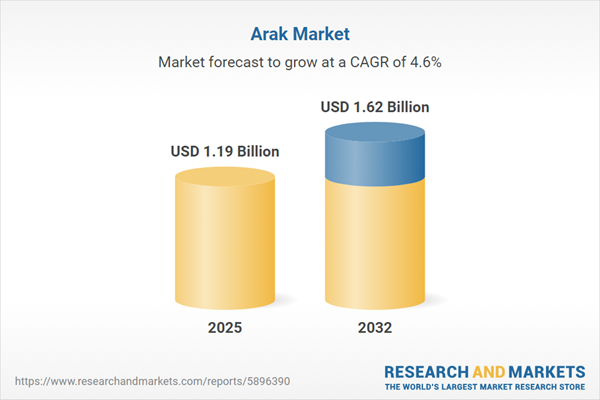Speak directly to the analyst to clarify any post sales queries you may have.
Arak’s position as a culturally significant spirit is evolving, with its market landscape shaped by innovation, shifting consumer profiles, and new trade realities. Senior stakeholders navigating this dynamic sector must align operational strategies with both heritage value and modern growth drivers while responding to fast-changing regional and regulatory conditions.
Market Snapshot: Arak Market Size and Growth
The Arak Market grew from USD 1.13 billion in 2024 to USD 1.19 billion in 2025. It is expected to continue growing at a CAGR of 4.56%, reaching USD 1.62 billion by 2032. This robust expansion is underpinned by rising global demand for artisanal and heritage spirits, with producers adopting modern operational models and supply chain innovations to capture new market opportunities. The marketplace remains highly responsive to both evolving consumer expectations and regulatory pressures across key regions.Scope & Segmentation
This report analyzes the global Arak industry across comprehensive dimensions to equip stakeholders for informed decisions:
- Distribution Channels: Off-trade and on-trade sales networks spanning supermarkets, specialty liquor retailers, bars, and restaurants.
- Alcohol Content: Varieties including moderate, strong, and ultra-high proof, reflecting a spectrum of consumer tastes and brand positioning strategies.
- Packaging Size: Multiple formats such as 1.5L, 1L, 750ml, and 500ml, meeting diverse consumption occasions from communal gatherings to on-the-go gifting.
- Price Tier: Segments including economy, premium, and luxury, each addressing distinct buying behaviors and margin profiles.
- Regional Analysis: In-depth coverage of Americas (United States, Canada, Mexico, Brazil, Argentina, Chile, Colombia, Peru), Europe, Middle East & Africa (United Kingdom, Germany, France, Russia, Italy, Spain, Netherlands, Sweden, Poland, Switzerland, United Arab Emirates, Saudi Arabia, Qatar, Turkey, Israel, South Africa, Nigeria, Egypt, Kenya), and Asia-Pacific (China, India, Japan, Australia, South Korea, Indonesia, Thailand, Malaysia, Singapore, Taiwan).
- Company Landscape: Strategic analysis of key industry leaders such as Al Wadi Al Akhdar S.A.L., Massaya S.A.L., Société des Produits Vinicoles du Liban S.A.L., and others.
Segmentation uncovers purchase drivers, supply chain strengths, and target opportunities in each segment and geography.
Key Takeaways: Navigating Arak Market Complexities
- Consumer appetite for authentic and premium crafted spirits is accelerating, supported by a move toward higher quality and provenance-driven product lines.
- Emergent trends—including flavor infusions, sustainable packaging, and limited-edition offerings—signal increased need for R&D and agile product development.
- Digital commerce and virtual engagement are allowing Arak producers to access and educate new consumer bases, especially in emerging and remote markets.
- Channel strategies must balance volume-driven off-trade success with value-driven on-trade experiences, optimizing both reach and brand storytelling.
- Collaboration across the value chain, from ingredient sourcing to distribution partnerships, underpins continued competitive advantage and operational resilience.
Tariff Impact: Adapting to U.S. Trade Changes
The introduction of United States tariffs in 2025 significantly re-shaped Arak trade flows. Exporters faced increased costs and adjusted their logistical, pricing, and supplier strategies. Some brands redirected shipments to more favorable markets or pursued contract production agreements to avoid excessive duties. Premium offerings absorbed pricing shifts more easily, while economy segments focused on promotional initiatives to sustain market share. Leading companies diversified supply routes and adopted advanced inventory systems to navigate ongoing trade disruption.
Methodology & Data Sources
This analysis leverages a multi-stage methodology, blending secondary research, structured executive interviews, and proprietary datasets. Quantitative rigor was achieved through triangulation of market data, trade statistics, and retailer filings, while expert validation ensured that patterns reflect regional market realities. Documentation of sources and review protocols enhances the credibility and relevance of insights.
Why This Report Matters
- Enables senior leaders to benchmark operational models and product portfolios against global competitors and shifting consumer expectations.
- Delivers actionable recommendations for supply chain realignment, digital transformation, and risk management to withstand regulatory and geopolitical challenges.
- Supports investment prioritization across regions and channels by illuminating emerging growth areas and under-served market segments.
Conclusion
The Arak market’s transformation will reward companies with strategies tuned to both tradition and agile innovation. Stakeholders prepared with actionable market intelligence can steward sustainable growth, operational excellence, and competitive market positioning as the sector continues to evolve.
Additional Product Information:
- Purchase of this report includes 1 year online access with quarterly updates.
- This report can be updated on request. Please contact our Customer Experience team using the Ask a Question widget on our website.
Table of Contents
3. Executive Summary
4. Market Overview
7. Cumulative Impact of Artificial Intelligence 2025
Companies Mentioned
The companies profiled in this Arak market report include:- Al Wadi Al Akhdar S.A.L.
- Massaya S.A.L.
- Société des Produits Vinicoles du Liban S.A.L.
- Société des Vins du Liban S.A.L.
- Kefraya S.A.L.
- Wardy S.A.L.
- Haddad Bros. S.A.L.
- Jallab Distillers S.A.L.
- Coteaux de Tannourine S.A.R.L.
- Bekaa Valley Distillers S.A.L.
Table Information
| Report Attribute | Details |
|---|---|
| No. of Pages | 183 |
| Published | November 2025 |
| Forecast Period | 2025 - 2032 |
| Estimated Market Value ( USD | $ 1.19 Billion |
| Forecasted Market Value ( USD | $ 1.62 Billion |
| Compound Annual Growth Rate | 4.5% |
| Regions Covered | Global |
| No. of Companies Mentioned | 11 |









